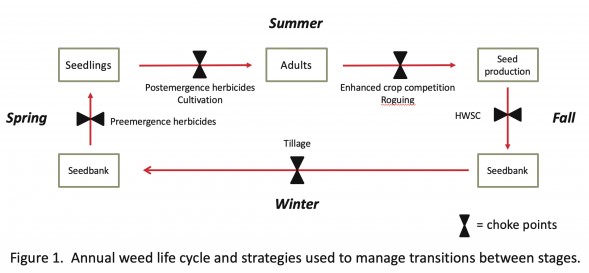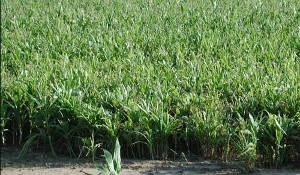By Bob Hartzler
While herbicide resistance is not a new issue, the rapid increase in multiple resistant biotypes in waterhemp, giant ragweed, and horseweed (marestail) is limiting herbicidal options. A waterhemp biotype resistant to six herbicide groups (2, 4, 5, 9, 14, and 27) was recently identified in Missouri. The majority of Iowa fields have waterhemp resistant to three herbicide groups, and five-way resistant populations have been found. While herbicides will remain the backbone of weed management systems for the foreseeable future, it should be clear that additional tactics are needed. This article focuses on alternative strategies that fit our current cropping system, with an emphasis on harvest weed seed control (HWSC). While none are as easily adopted as changing herbicide programs, they will be essential for preserving herbicides as effective management tools.
Identifying weak links in a weed’s life cycle
Summer annuals are the dominant weed problem in the corn-soybean rotation since these pests establish and mature at the same time as the crops. The annual life cycle has several distinct stages, the success at transitioning between these stages determines whether a weed increases or decreases within a field (Figure 1). Population dynamic models allow researchers to investigate how control tactics targeting different ‘choke points’ influence the long-term success or failure of a weed.

Current weed management programs primarily target weeds as they emerge from the seed bank (preemergence herbicides) or as they develop from seedlings (postemergence herbicides). While these tools are highly effective, the increase in herbicide resistance raises concern regarding their sustainability. Population dynamic models reveal that weeds are very sensitive to changes in the number of seed that enter the seed bank, thus tactics that reduce seed production or their entry into the seedbank have a large impact on the long-term success of the weed. A population model evaluating the benefit of HWSC in delaying the onset of resistance showed that destroying approximately 50% of weed seed at harvest delayed resistance evolution by nearly 10 years (Somerville et al. 2018).
Harvest weed seed control (HWSC)
Preventing seed produced by weed escapes from entering the seed bank is an effective approach to weed management. The first mechanized combines often were equipped with weed seed collectors to prevent weed seed from being returned to fields. Walking beans was a rite of passage for generations of Iowa farm kids. However, with the introduction of modern herbicides and increases in farm size, these tactics have fallen out of favor. HWSC is one of the few alternatives to herbicides that can be incorporated within Iowa’s production system without significantly increasing labor requirements.
The interest in HWSC has been driven by Australia’s struggle with herbicide resistant weeds. Western Australia is recognized as the herbicide resistant weed capital of the world due to the widespread occurrence of multiple resistant weeds. The loss of effective herbicides for several important weed species, especially annual ryegrass (Lolium rigidum) in wheat production, has forced the development of innovative approaches to managing weed seed before they enter the seedbank. A survey of Australian farmers in 2014 found that 82% of respondents expected to use some form of HWSC within 5 years (Walsh et al. 2017).
Australians have developed several HWSC techniques, including chaff carts, baling of crop residues, chaff tramlining, narrow-windrow burning, and weed seed destruction (Walsh et al. 2017). Narrow-windrow burning is the most widely used HWSC practice in Australia (Table 1). This strategy involves altering how the combine manages crop residue during harvest (Walsh and Newman 2007). Relatively simple modifications are made to concentrate the chaff in a narrow windrow that is later burned. Research has shown that 70 to 80 percent of weed seed is collected by the combine and concentrated in the chaff, and nearly all of these seeds are killed by fire. The use of this practice in Western Australia has increased from 15% of farmers in 2004 to more than 50% of farmers in 2014. Due to differences in crops and climate, this tactic may not be effective in Iowa, but its widespread adoption demonstrates the value of targeting weed seed at harvest.

Probably most applicable for Midwest cropping systems are chaff mills, devices that destroy weed seed during harvest (Schwartz-Lazaro et al. 2017). Chaff, which contains the majority of weed seed, is separated from other plant material as it moves through the combine. The chaff is run through a rolling cage mill that damages seed sufficiently to render them non-viable. The original design, the Harrington Seed Destructor, was a separate unit pulled behind the combine. More recently, chaff mills are integrated into the back of the combine.
Factors that influence the effectiveness of chaff mills are how long seed are retained on weeds and the ability of the mill to destroy seed. Seed retention varies widely among species. Chaff mills or other forms of HWSC would have little value for managing giant foxtail since most seeds fall from plants prior to harvest. Weed scientists at the University of Illinois found that 72, 92, and 95% of waterhemp seed remained on the plant at the time of soybean harvest in three years of research (A.S. Davis, unpublished data). The value of HWSC for waterhemp would be diminished in years with late harvest, such as in north central Iowa in 2018. Tests with a wide range of weed seeds have shown that greater than 95% of seed entering the mill is rendered non-viable, thus retention on the plants is the limiting factor in the effectiveness of this tactic.
Destroying weed seeds with combine modifications, therefore reducing the return of seeds to the soil weed seedbank, is an effective way of reducing herbicide selection pressure and the resultant evolution of herbicide resistant weeds. But as they say, there is no free lunch. Early versions of chaff mills cost approximately $120,000, but people estimate that with mass production the cost could be reduced by at least 50%. In addition to the cost of the equipment, there are several factors that pose challenges to this technology. Current versions require approximately 80 to 100 horsepower, this power drain can result in a 12-20% reduction in combine capacity (Anonymous 2018). The increased power requirement associated with weed seed destruction results in an average increase in fuel consumption of 0.4 gallon per ton of grain.
Currently there is limited experience using the chaff mills in corn or soybean, thus it is unclear how well they will perform in our system. Green stems of crops and weeds negatively impact mill performance, frequently blocking flow of the chaff through the mill. The University of Arkansas has the only integrated chaff mill in the United States, and they report that it has worked better in corn than in soybean. The problems in soybean likely are associated with the green material frequently present during soybean harvest.
Another issue with the chaff mills has been rapid wear of the mill components. Manufacturers estimate that rotors should have a useable life of 800 hours, but most Australian owners of the equipment report lives of less than half that. Replacement cost for rotors is more than $2000. The low cutting height of soybean probably would reduce the lifespan of rotors more than when harvesting corn due to greater amount of soil on the soybean residue.
At this time, most Iowa farmers would not consider weed management a big enough problem to warrant the expense and inconvenience of adopting HWSC. Australia’s farmers went this route only after weeds developed resistance to nearly all herbicides available for their cropping system. The increasing pace of herbicide resistance evolution and the slow introduction of new herbicide sites of action suggest we will face the same dilemma in the not-too-distant future. To prevent further loss of effective herbicides, attitudes towards weed management need to change. Reducing the size of the weed seedbank must be viewed as just as important as protecting crop yields.
There are several issues with HWSC that limit its utility in our system at this time. However, it is important to recognize that this is new technology for which the bugs are being worked out. Weed problems are severe enough in Australia that many farmers are willing to tolerate the problems associated with the equipment. Currently there are only two versions of the chaff mills on the market. At least three other companies are involved in designing new equipment; these companies have greater resources available for supporting development than the initial companies. In addition to reducing the cost of the equipment, it is likely that some of the current limitations to the internal chaff mills will be resolved. Until HWSC is more widely available and convenient to implement, farmers must take steps to optimize both the effectiveness of herbicide programs and the suppressive ability of the crop.